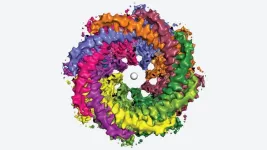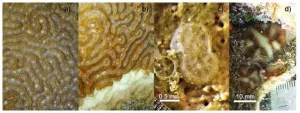(Press-News.org) University of Virginia School of Medicine researchers have discovered a way to identify pregnant women at risk of preeclampsia, a serious disorder characterized by high blood pressure and kidney dysfunction which can result in premature delivery, seizures and even death. Complications from the condition are the second-leading cause of maternal death around the world.
The UVA scientists, led by Charles E. Chalfant, PhD, found that they could predict the risk of preeclampsia by examining lipids (fats) in women’s blood during pregnancy. The researchers say their finding opens the door to simple blood tests to screen patients.
Further, the approach worked regardless of whether the women were on aspirin therapy, which is commonly prescribed to women thought to be at risk.
“Clinicians have been seeking simple tests to predict risk of preeclampsia before symptoms appear. Although alterations in some blood lipid levels have been known to occur in preeclampsia, they have not been endorsed as useful biomarkers. Our study presents the first comprehensive analysis of lipid species, yielding a distinctive profile associated with the development of preeclampsia,” said Chalfant, of the School of Medicine’s Division of Hematology and Oncology and the Department of Cell Biology. “The lipid ‘signature’ we described could significantly improve the ability to identify patients needing preventative treatment, like aspirin, or more careful monitoring for early signs of disease so that treatment could be initiated in a timely fashion.”
Understanding Preeclampsia
Preeclampsia affects up to 7% of all pregnancies. Symptoms typically appear after 20 weeks and include high blood pressure, kidney problems and abnormalties in blood clotting. The condition is associated with dangerous complications such as kidney and liver dysfunction and seizures, as well as a lifelong increased risk of heart disease for the mothers. An estimated 70,000 women around the world die from preeclampsia and its complications each year.
Doctors commonly recommend low-dose aspirin for at-risk women, but it works for only about half of patients, and it needs to be started within the first 16 weeks of pregnancy – well before symptoms appear. That makes it all the more important to identify women at risk early on, and to better understand preeclampsia in general.
Chalfant and his team wanted to find “biomarkers” – biological indicators – in the blood of pregnant women that could reveal their risk of developing preeclampsia. They examined blood plasma samples collected from 57 women in their first 24 weeks of pregnancy, then looked at whether the women went on to develop preeclampsia. The researchers found significant differences in “bioactive lipids” in the blood of women who developed preeclampsia and those who did not.
This, the researchers say, should allow doctors to stratify women’s risk of developing preeclampsia by measuring lipid changes in their blood. The changes represent an important “lipid fingerprint,” the scientists say, that could be a useful tool for identifying, preventing and better treating preeclampsia.
“The application of our comprehensive lipid profiling method to routine obstetrical care could significantly reduce maternal and neonatal morbidity and mortality,” Chalfant said. “It represents an example of how personalized medicine could address a significant public health challenge.”
Findings Published
The researchers have published their findings in the Journal of Lipid Research. The multi-disciplinary team consisted of Daniel J. Stephenson, H. Patrick MacKnight, L. Alexis Hoeferlin, Sonya L. Washington, Chelsea Sawyers, Kellie J. Archer, Jerome F. Strauss, III, Scott W. Walsh and Chalfant. The researchers have no financial interests in the work.
To keep up with the latest medical research news from UVA, subscribe to the Making of Medicine blog.
END
Lipid test can reveal risk of preeclampsia, a potentially deadly pregnancy complication
2023-07-14
ELSE PRESS RELEASES FROM THIS DATE:
Stellar cradles and graves seen in farthest galaxy ever
2023-07-14
New observations using the Atacama Large Millimeter/submillimeter Array (ALMA) have distinguished the sites of star formation and a possible site of star death from the surrounding nebula in a galaxy 13.2 billion light-years away. This is the farthest that such structures have been observed.
A team led by Yoichi Tamura, an astronomer at Nagoya University, attempted high-resolution observations of MACS0416_Y1, located 13.2 billion light-years away in the constellation Eridanus. Previous observations of this galaxy by the same team had detected radio waves emitted by both oxygen and dust, two components of interstellar nebulae. Detailed observations of the ...
Liquid crystals that mimic beetle shell coloration units used to create more secure type of QR code
2023-07-14
A research group led by Dr. Jialei He of Nagoya University's Graduate School of Engineering has developed a method for processing cholesteric liquid crystals (CLCs) into micrometer-sized spherical particles. CLCs are a type of liquid crystal that possess a helical structure, giving them unique optical properties and the ability to selectively reflect light. By combining spherical CLC particles with commercially available pigments, the researchers developed a unique anti-counterfeiting QR code that can only be displayed under a specific circular polarizer. The results were published in the journal Advanced Optical Materials.
CLCs are an example of how nature can be ...
ROSE: a revolutionary, nature-inspired soft embracing robotic gripper
2023-07-14
Ishikawa, Japan -- Although grasping objects is a relatively straightforward task for us humans, there is a lot of mechanics involved in this simple task. Picking up an object requires fine control of the fingers, of their positioning, and of the pressure each finger applies, which in turn necessitates intricate sensing capabilities. It’s no wonder that robotic grasping and manipulation is a very active research area within the field of robotics.
Today, industrial robotic hands have replaced humans in various complex and hazardous ...
Study shows surprisingly low use of COVID antiviral treatments in nursing homes
2023-07-14
Nursing homes were a key battleground during the COVID pandemic and prioritized for distribution of PPE, vaccines, and COVID testing kits. However, new research shows that monoclonal antibodies and oral antiviral drugs were not used in these facilities as much as would be expected given the high-risk of resident populations.
Brian McGarry, PhD, with the University of Rochester Medical Center, and collaborators at Harvard University, authored the new study, which appears today in JAMA. The authors examined data compiled ...
This eight-armed octopus-like pore detects taste
2023-07-14
The neurons in our bodies are dotted with tiny pores that let essential molecules pass in and out of our cells. Neurons need these channels to send the signals that allow us to move, think, and perceive the world around us. Now, structural biologists at Cold Spring Harbor Laboratory (CSHL) have captured never-before-seen images of one of the largest pores in human neurons. It’s called calcium homeostasis modulator protein 1, or CALHM1 for short.
Previous studies have shown that mutations in the Cahlm1 gene may be a risk factor for Alzheimer’s disease. CSHL’s new ...
New study demonstrates the potential of diseased coral parents in restoring stony coral tissue loss disease-affected species
2023-07-14
Stony Coral Tissue Loss Disease (SCTLD) has wreaked havoc on coral reefs across the Caribbean, resulting in significant mortality of various coral species, including Pseudodiploria strigosa, which has been particularly affected in the Mexican Caribbean. In response to the decreased abundance and colony density caused by SCTLD, scientists have explored larval-based restoration methods, despite concerns about disease transmission. A new PeerJ Life & Environment study reveals that even colonies affected by SCTLD can play a vital role in the assisted sexual reproduction for the restoration of SCTLD-susceptible species.
The ...
Owning a pet does not reduce symptoms of severe mental illness, study shows
2023-07-14
Living with and having a close bond with a companion animal does not necessarily lead to significant mental health improvements in people with a serious mental illness, say researchers.
A survey, conducted by the University of York, revealed that living with an animal - a dog, cat, fish or bird for example - did not improve wellbeing or reduce depression, anxiety or feelings of loneliness for owners with serious mental illness, such as bipolar disorder or schizophrenia, compared to those who live without an animal.
The researchers, who followed up on an earlier survey conducted in 2021 on investigating aspects of animal ownership and mental ...
AI brings hope for patients with lyosomal storage disease
2023-07-14
Artificial intelligence is becoming increasingly important in drug discovery. Advances in the use of Big Data, learning algorithms and powerful computers have now enabled researchers at the University of Zurich (UZH) to better understand a serious metabolic disease.
Cystinosis is a rare lyosomal storage disorder affecting around 1 in 100,000 to 200,000 newborns worldwide. Nephropathic (non-inflammatory) cystinosis, the most common and severe form of the disease, manifests with kidney disease symptoms ...
Pets do not significantly benefit the emotional health of owners with severe mental illness, study shows
2023-07-14
A new study published in the CABI journal Human-Animal Interactions suggests that companion animals – including dogs, cats, fish and birds – do not significantly benefit the emotional health of owners with severe mental illness.
Results showed that owning an animal was not significantly associated with the wellbeing, depression, anxiety or loneliness scores for owners with a range of severe mental illnesses such as bipolar disorder or psychosis.
The researchers, who followed up on an earlier survey conducted ...
Scientists knit futuristic eco-building designs using fungal networks
2023-07-14
Scientists hoping to reduce the environmental impact of the construction industry have developed a way to grow building materials using knitted molds and the root network of fungi. Although researchers have experimented with similar composites before, the shape and growth constraints of the organic material have made it hard to develop diverse applications that fulfil its potential. Using the knitted molds as a flexible framework or ‘formwork’, the scientists created a composite called ‘mycocrete’ which is ...





